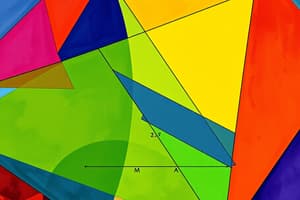Podcast
Questions and Answers
What is the formula for finding the area of a square?
What is the formula for finding the area of a square?
How is the area of a parallelogram calculated?
How is the area of a parallelogram calculated?
What is the formula for finding the area of a right triangle?
What is the formula for finding the area of a right triangle?
How can the area of a complex figure be determined?
How can the area of a complex figure be determined?
Signup and view all the answers
What is the formula for finding the area of a trapezoid?
What is the formula for finding the area of a trapezoid?
Signup and view all the answers
What is the difference between area and perimeter?
What is the difference between area and perimeter?
Signup and view all the answers
What is the formula to calculate the circumference of a circle with a known radius?
What is the formula to calculate the circumference of a circle with a known radius?
Signup and view all the answers
How do you calculate the perimeter of a regular polygon with 'n' sides and side length 'a'?
How do you calculate the perimeter of a regular polygon with 'n' sides and side length 'a'?
Signup and view all the answers
What is the formula to calculate the perimeter of a rectangle with length 'l' and width 'w'?
What is the formula to calculate the perimeter of a rectangle with length 'l' and width 'w'?
Signup and view all the answers
How do you find the area of an irregular polygon?
How do you find the area of an irregular polygon?
Signup and view all the answers
What is the perimeter of a circle with a diameter of 10 units?
What is the perimeter of a circle with a diameter of 10 units?
Signup and view all the answers
Study Notes
Math: Focusing on Area and Perimeter
Mathematics is a diverse field that encompasses numerous concepts, including those related to geometry, such as area and perimeter. These concepts play a crucial role in problem-solving and spatial reasoning. Let's explore how area and perimeter are defined and applied in real-world contexts.
Area
Area refers to the amount of space occupied by a two-dimensional figure. It is measured in square units, such as square inches, square centimeters, or square feet. Common methods for finding the area of basic shapes include counting squares, using predefined formulas, and decomposing complex figures into simpler ones.
Square and Rectangle
The area of a square can be calculated by multiplying the side length by itself (square of the side length). For a rectangle, the area is found by multiplying its length and width. This principle extends to composite rectangles by dividing the larger rectangle into smaller rectangles and adding the areas together.
Parallelogram and Trapezoid
To find the area of a parallelogram, multiply the base by the height and divide by 2. The area of a trapezoid involves finding the average of the areas of the two parallel bases and multiplying by the difference in heights.
Triangle
For a right triangle, the area is half the product of the base and height. For any triangle, area can be determined by finding the area of two non-parallel bases and subtracting the overlap between them.
Irregular Polygon
To find the area of an irregular polygon, divide it into several smaller regular polygons and rectangles, find the area of each, and add them up.
Perimeter
Perimeter represents the distance around the outside boundary of a closed figure. It is also measured in linear units. The calculation of perimeter varies depending on the shape:
Rectangle
To find the perimeter of a rectangle, multiply twice the length plus twice the width.
Circle
The perimeter of a circle is called the circumference, which can be calculated using the formula Circumference = 2 * pi * radius for circles with known radius values. If only the diameter is given, the radius is half the diameter.
Regular Polygon
For a regular polygon with 'n' sides and a side length 'a', the perimeter is P = na.
These formulas can be adapted to find the perimeter of irregular polygons and any combination of straight lines.
In summary, area and perimeter are fundamental aspects of geometry that help us understand the properties and dimensions of various shapes. By applying these concepts, we can model real-world phenomena such as calculating the total cost of fencing a field or determining the size of a container for storing a certain volume of material.
Studying That Suits You
Use AI to generate personalized quizzes and flashcards to suit your learning preferences.
Description
Delve into the fundamental concepts of area and perimeter in geometry, which play a crucial role in spatial reasoning and problem-solving. Learn about calculating the space occupied by two-dimensional figures and the distance around their boundaries, as well as the formulas for basic shapes like squares, rectangles, triangles, circles, and irregular polygons.




